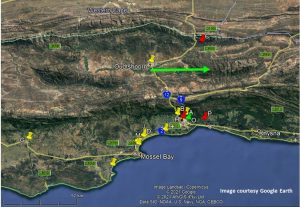August 2021
Several persons reported hearing sounds at around 1am on the morning of August 9. Locations included Riversdale, Mossel Bay, Oudtshoorn, Boggoms Bay, George, Hartenbos, Klein Brak River, Wilderness and De Rust, spanning a horizontal distance of around 115 km. The most westerly location where sounds were reported was Riversdale, where it was described as a rumble, like distant thunder. The most easterly was from several observers in the environs of George, where the sounds were mostly described as rumbling like thunder. From Oudtshoorn the sound was also likened to distant thunder. Others said it sounded like an explosion, houses shook and windows rattled.
Only three visual sightings were received of the bolide. The best description was received from Ted Nutting, who was outdoors at the time and saw the passage of a bright green fireball in a clear sky, duration about 4 seconds moving west to east, and disintegrated into four or five fragments with a bright flash before disappearing. Sounds were heard about two minutes later, as up to four distinct ‘bangs’ and tailing off afterwards like the sound of a jet flying over. Triangulation of the start and end points gives a tentative path from west to east, seen towards the north from George, but to the south from near De Rust, where the start and end azimuths were 230° and 180° respectively, traveling parallel to a rooftop, at altitude 60-70°. Frankie Dos Santos saw the bolide through a window facing azimuth 330° from Hoekwil, near Wilderness. He described the fireball as ‘very bright, much bigger than a normal shooting star’, moving left to right (towards north east) at an altitude of about 45°, and very fast with a duration of about a second. The sky was overcast with thin patchy clouds and the appearance was like seeing car headlights through fog. The bolide possibly began ablation near overhead and just south of Oudtshoorn, and disrupted in the vicinity above Kammanassie Nature Reserve. Fragments may have fallen as meteorites near to the Kammanassie Mountain range.
In order to determine the fall location of possible meteorites, sufficient video footage is required which shows both the passage and disruption of the bolide, or shadows cast by the flash, which are in the anti-direction of the disruption. Unfortunately, despite requests on various forums to check security cameras, only one clip was received, from Godwin Pangel in George. The clip shows a brief very bright flash, with duration less than 1 second, and was followed 2m56s later by a booming sound. The sky is seen to be mainly overcast at the time of the bright flash. The video footage was calibrated against internet time to give the time of the flash as August 9, 01:00:30 SAST. The time lag of the sound gives a distance to the flash of approximately 60km.
The event was not detected by NASA fireball detectors, neither were there any reports to the ASSA, AMS nor IMO reporting forums. I conclude that a bright bolide passed roughly west to east over the Western Cape, disrupting with a bright flash, and with accompanying sounds. Insufficient video evidence could be obtained that could have enabled determination of a strewn field site for meteorites.
Several misconceptions arose in the social media in connection with the event. Firstly the statement on some social media pages that the event was a ‘skyquake’. There is no accepted scientific definition of what constitutes a ‘skyquake’; rather it appears to be a loose term originating on the internet describing rumbling sounds from unexplained sources, including possibly the sonic boom from meteors. Since the bolide was observed visually, the suggestion that it was a ‘skyquake’ is clearly of no consequence.
Secondly that the event might be linked to the Perseid meteor shower, which normally peaks during the night of August 11/12, and showed an unexpected surge in activity this year on August 14 at 10am SAST, the outburst lasting about two hours. The August 9 event was not related to the normal activity or the outburst of the Perseids. The Perseid meteor stream is known debris from comet 109P/Swift-Tuttle, and particles from comets are too small to produce effects like that witnessed over the Western Cape on August 9. The radiant of the meteors in the constellation of Perseus only rises early morning and is highest before dawn, and even then the radiant does not rise above the horizon at any time as seen from the George/Mossel Bay area. Finally, the radiant is located in the north-east in the early morning and cannot explain any meteor observed on a trajectory from west to east.
Thirdly the misconception that what was seen was a meteorite. Particles travelling through space are termed meteoroids. If they enter the atmosphere then the resultant streak of light is termed a meteor. Bright meteors are termed fireballs, and if seen to explode they are called bolides. If the object survives its passage through the atmosphere, reaches the ground and is recovered then it is termed a meteorite. Since no videos were obtained to triangulate the path and hence no fragments could be found on the ground, the event on August 9 is classified as a bolide.

Possible path of the August 9 bolide. Yellow pins are locations where sounds were heard, red pins are locations of the three observers who actually saw the bolide, green pin is the location of the one video which caught the bright flash.
